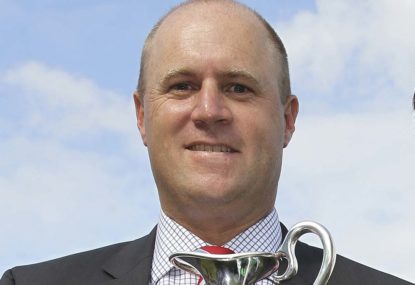TWO GOOD! Zahra wins back-to-back Melbourne Cups on Without a Fight as three horses pull up lame
Without a Fight completed the rare Caulfield Cup-Melbourne Cup double on Tuesday as star jockey Mark Zahra went back-to-back in the big one after…

The 2014-15 racing season officially came to an end on July 31st and after using the last couple of weeks to take stock, I decided it was time to provide an update on some of racing’s biggest issues.
The Sam Kavanagh case
Let’s start with the cobalt crisis, which seems to take a new turn at every hearing.
Over the last couple of weeks a direct link to the vet who is involved in the Mark Kavanagh and Danny O’Brien cobalt case in Victoria has emerged. This man is Tom Brennan, who initially lied about his involvement in the saga.
However, the most concerning aspect of the cobalt inquiry is the involvement of ATC executive manager of racing Matt Rudolph. Rudolph, the brother of Racing NSW’s deputy chief steward, Greg, allegedly pressured Sam Kavanagh into changing his story in order to protect his friend, Tom Brennan.
Facts and statements continue to be given, with more evidence to be tendered by the Deputy Chairman of the ATC over the coming weeks.
The $28 million black hole for Racing Queensland
A little over ten weeks ago the Racing Queensland board was abolished by the Queensland government in response to the live-baiting greyhound scandal.
The board was replaced by administrators from accounting firm KPMG in order to ensure Racing Queensland’s day-to-day operations continued as usual.
Since the board was abolished there have been multiple leaks surrounding the financial state of Racing Queensland. Reports claim that the organisation lost $12 million in 2014-15 and is set to lose $28 million in 2015-16.
Despite the reports, no financial details have been tendered and all requests for interviews and information have been rejected. The government has not set a timetable for the publishing of the annual results of the 2014-15 financial year and the annual report.
Prizemoney decreases for Tasmania racing
Unfortunately the situation is not much better in Tasmania.
Less than 12 months ago Tasracing looked to be in a very strong position, they had just released a buoyant annual report and announced a sponsorship agreement with betting firm Betfair.
However, we have recently learnt that the industry is facing a major loss, with unsustainable prize money levels taking much of the blame.
After a numerous news articles laid the blame on executive salary levels, Chairman Brian Speers released an intriguing statement late last week.
In response to enquiries regarding a timetable for the publishing of an annual report, Tasracing stated “It is a matter for government when they table it in Parliament. Usually late October or early November.”
Transparency and timely reporting
One of the major lessons learnt from the demise of TVN was that racing lacks transparency and annual reports need to be released earlier in order to give a clearer indication of the state of the club or jurisdiction.
All racing clubs and jurisdictions have financial years ending in either June or July, yet they fail to release their annual reports until September at the earliest or December at the latest.
Tabcorp the major industry partner, an ASX listed company and an organisation with what appears to be a much more complex financial reporting entity will release its annual results on Thursday.
The release of the report will be accompanied by a live webcast with CEO David Attenborough who will also be answering questions. In the business world this is nothing out of the ordinary, it is what is required and expected by the financial community and investors.
Given this, why do we have to wait until September, October, November and even December for annual results? The earliest I have heard is the Melbourne Racing Club with its AGM and release of results on September 24th. Racing Victoria, NSW and Queensland all have major delays indicating that reports first need to be tabled in parliament.
The VRC will not report until just before Christmas, extraordinary when you consider this year’s Melbourne Cup will have been run and won more than a month before members receive financial results from last year’s race.
Racing Australia rule making
Since the new inception of Racing Australia, the body has made three major decisions.
All three of these decisions were announced with very little input from the public and racing stakeholders. As a result, the rules have been vigorously debated following their announcement.
The debates have surrounded both the merit of the rule changes and the actual rule-making process, with the lack of consultation with those in the industry a particular concern.
The three new rules include a new whip rule, that restricts the number of times a jockey can whip their horse prior to the final 100 metres to five.
Additionally, horses will now be forced to retire at the age of 13, no matter their health, and the controversial credit card rule for owners.
The new credit card rule will force all owners to provide Racing Australia with private credit card information in order to facilitate automatic payments to trainers.